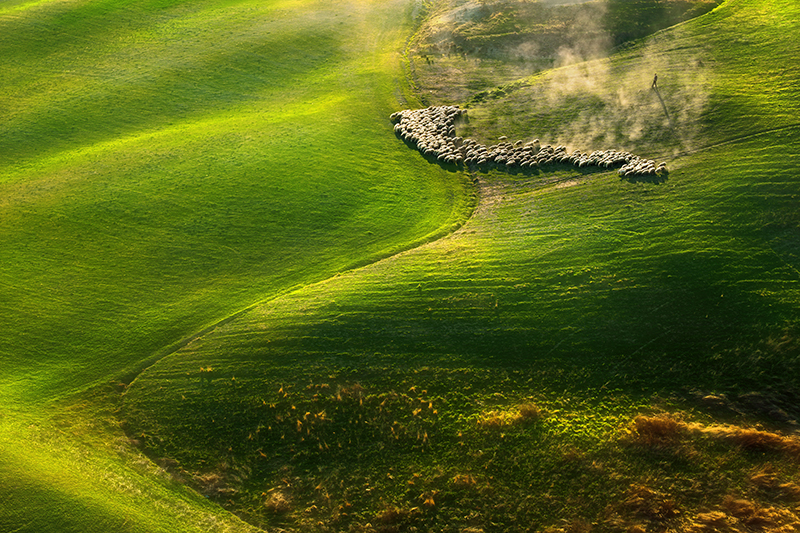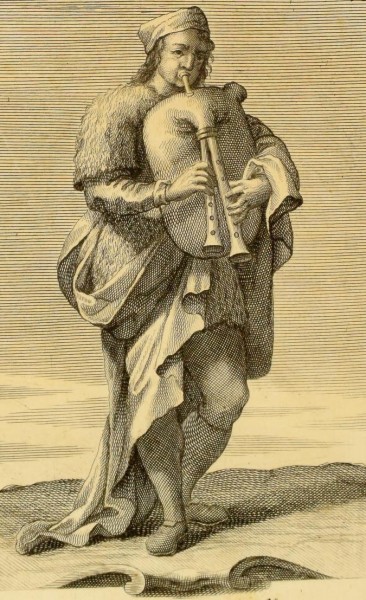Program Notes by Lucas Harris, Tafelmusik lutenist and member of Vesuvius Ensemble
In 2009, a young Italian American named David Marker took a break from his law school studies to travel through Italy filming the documentary Zampogna: The Soul of Southern Italy(which he uploaded to YouTube for anybody to watch free of charge). The documentary makes clear that the tradition of the zampogna — the bagpipes played for centuries by Italian shepherds — is in danger of being lost today. The aging zampogna makers and players featured in the documentary report that young people are not interested enough to carry the tradition forward. Indeed, many Italians today have never heard of the instrument. Neither did the zampogna tradition travel across the ocean with the thousands of Italian immigrants who came to make a new life in Canada or the US. Perhaps they were eager to leave any vestiges of peasant identity behind in their hopes for a better life.
And yet, the zampogna will sound here tonight! Tafelmusik and the Vesuvius Ensemble are keen to do our part in preserving this tradition and proudly feature our bagpiper friend Tommaso Sollazzo, who has travelled from Vallo della Lucania (Campania, Italy) to be with us. You might have heard Tommaso make a cameo appearance at Tafelmusik’s Sing-AlongMessiahin recent years. Indeed, this connection between the zampogna and Handel’s Messiahpoints to another important goal of this concert: to show how the sounds of the zampogna have come to be forever immortalized in pastoralemovements by baroque composers. Whether or not they realize it, choirs and orchestras all around the world are sounding echoes of the zampogna when they program holiday favourites such as the Messiah, Bach’s Christmas Oratorio, or Corelli’s Christmas Concerto.
The word “zampogna” likely comes from the Aramaic word sumponyah, which first appears in the book of Daniel (c. 500 B.C.). It is also related to the Greek word symphonia, meaning “many sounds played together,” and has a backstory in Greek mythology: the goddess Athena is supposed to have invented the aulos (double-reed pipe), but threw the instrument away when her beauty was disfigured by her grossly inflated cheeks! Players of the auloi, especially those who sounded two pipes at once or used circular breathing techniques, tended to get puffed-up cheeks, and thus risked invoking the so-called “reproach of Athena.” They invented a leather strap called the phorbeia to hold their cheeks in, but eventually they got the idea to attach the pipes to an external air bladder — problem solved!
This new bagpipe come to the Italian peninsula during Greek and/or Roman times (the emperor Nero was a celebrated bagpiper), likely through the region of Southern Italy known as Magna Grecia. It was probably during the medieval period that the zampogna began to have a regular role in cultural and religious events.
The zampogna is artisanally constructed from a goat hide that is removed from the slaughtered animal in a single piece, then cured and turned inside out. Three of the legs are tied off, and the fourth is used to house the blowpipe. A wooden block inserted into the neck houses all the instrument’s pipes, both chanters and drones. The exact arrangement and tuning of the pipes differ according to many regional traditions. The reeds, whether single or double, are carved from arundo donax cane.
The zampogna has long been closely associated with spirituality and religion. Around the beginning of the 17th century, a Dominican monk in Naples had a divine vision that the number nine appeared upon the bible he was reading. Thus emerged the novena, a term which carries a few different meanings. It refers to a special time of public prayer during the nine days leading up to Christmas (representing the nine months of Mary’s pregnancy), as well as to the zampogna music which accompanied these prayers. In addition, it carries the meaning of “good news” about Christ’s birth. Our program begins with an instrumental novena followed by Saint Alfonso Maria de Liguori’s novena“ Per la nascita di Gesù,” whose original text in Neapolitan dialect has around 25 verses. Also known as the “Canzone d'i zampognari,” it is the direct ancestor of the popular carol “Tu scendi dalle stelle” in standard Italian.
A tradition developed, particularly in Southern Italy and Sicily, of shepherd musicians descending from the mountains during the novena period to serenade villages. These zampognari (or pifferari) often performed in teams of two, with one of them playing the ciaramella (or piffaro), a kind of rustic shawm that has been taken up by Tafelmusik’s own Marco Cera. The zampognari are seen to be custodians of the very music sung by the angels at Christ’s birth. They often performed in front of a village’s public nativity scene, or presepe, which would typically include figurines of shepherd musicians along with the Holy Family, the Magi, & c. It is worth noting that the art of constructing these presepiis also a centuries-old tradition which began in medieval Italy and enjoyed a golden age during the 18th century. The tradition of the presepe napoletano is still alive today, especially in Naples’s Via San Gregorio Armeno.
It was customary for the villagers to give the shepherd musicians an offering of food: we see this in the song “La ’nferta,” in which the zampognaro wishes a lady’s son to become the King of Spain — but only if she gives him something tasty! The Kingdom of Naples (which was part of the Spanish empire) went through many periods of famine, and hunger became a frequent topic in Neapolitan literature and music. The “Canzone di Razzullo” comes from Andrea Perrucci’s Cantata dei Pastori, a Christmas play written in 1698 in which the comic character Razzullo is always famished. The words were set to music in the 20th century by Roberto de Simone, a composer/musicologist/stage director who has played an enormous role in the revival and preservation of traditional Italian music.
It was in the 17th century that composed musical works begin to imitate the sounds of the zampogna. Some of these were written for keyboard, such as the Pasquini organ work that we’ve arranged for orchestra. The most famous example is the final movement of Corelli’s Concerto grosso op.6, no.8, “fatto per la notte di Natale” (written for Christmas Eve). But many of Corelli’s contemporaries and successors in Italy and beyond tried their hand at this new pastorale genre, in both instrumental and vocal music. The pastorale is typically in a gently rocking motion, and the lilting melody is often accompanied by long bass notes, in imitation of the drone of the pipes.
Interestingly, pastoralemovements tend to imitate the zampogna using string instruments more often than winds. The Tartini movement for solo violin suggests the zampogna by using bowed chords made possible by an alternate tuning. String instruments are also not bound by the restrictions of the zampogna: pastorale movements don’t hesitate to modulate to different key centres and make use of dynamics: echo effects are typical, as well as “putting the baby to sleep” with a pianissimo finish.
Closely related to the pastorale is the ninna, a sort of lullaby to the Christ child, and sometimes the line between them is blurred. The gentle Scarlatti aria “Autor d'ogni mio ben” (here played on the oboe rather than sung) is a sort of ninnawithin a longer cantata whose opening movement is a pastorale. The “Ninna nanna di Carpino” is a lullaby from a village in the Gargano region of Apulia, here sung a cappella as Francesco Pellegrino heard it sung once by a villager.
It is worth noting that the zampognari didn’t always play tender religious music: the dall’Abaco cello sonata movement “La Zampogna” (here arranged for string orchestra) is more of a raucous festa, and so we asked Tommaso to introduce the piece with a tarantella in the same spirit. And even the Christmas music itself is not always so tender and precious: we finish each half with lighthearted Sicilian carols that invite spirited contributions from our zampognari. Another opportunity for these rustic pipes to be heard loud and clear in the 21st century!
Special thanks to: The cellist Elinor Frey, for introducing us to the dall’Abaco cello movement (Elinor has been preparing a CD and edition of some of dall’Abaco’s cello sonatas contained in a British Library manuscript).
Tafelmusik volunteer Eva Saphir for her purchase and loan of Vesuvius’s colascione by luthier Pasquale Scala. The colascioneis a long-necked lute with three strings that was used especially in Neapolitan street music and commedia dell’arte.
John Caliendo for his purchase of Vesuvius’s chitarra battente, also by Pasquale Scala.


